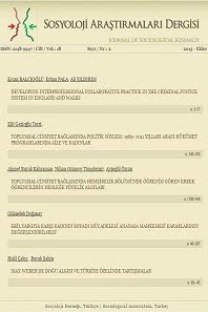Tüketicilerin Ankara'daki Üç Hipermarketi Tercih Etme Nedenleri
Araştırma Ankara'daki üç hipermarketten (Hipermarket A, B ve C) alış veriş eden tüketicilerle yapılmıştır. Çalışmanın amacı, hipermarketlerden alış veriş yapan müşterilerin profilinin saptanmasına, hipermarketleri tercih etmenin rasyonel, sosyokültürel/psikolojik nedenlerinin hipermarketlere göre farklılık arz edip etmediğinin belirlenmesine ve müşterilerin hipermarketleri neden tercih ettiğinin anlaşılmasına yöneliktir. Araştırmada hem nicel (anket) hem de nitel (mülakat ve odak grup) teknikler kullanılarak bilgi toplanmıştır. Araştırmada toplam 400 anket uygulanmıştır. Aynı zamanda bu denekler içinden toplam 22 kişi ile mülakat ve odak grup görüşmeleri yapılmıştır. Tüketicilerin rasyonel, sosyo-kültürel ve psikolojik niteliklerinin tüketim süreçlerine etkilerini bulabilmek için ki-kare, t-testi ve ANOVA analiz teknikleri kullanılmıştır. Araştırmanın sonucuna göre rasyonel, sosyo-kültürel ve sosyo-psikolojik nedenlerle Hipermarket A'nın Hipermarket B'nin ve Hipermarket C'nin tercih edilmesi farklı nitelikler taşımaktadır. Aynı zamanda tüketicilerin hipermarketleri tercih etme nedenleri cinsiyete, yaşa, mesleğe, eğitim düzeyine ve oturulan yere göre farklılıklar arz etmektedir.
The Reasons of Consumer Preferences of the Three Hypermarkets in Ankara
The main aim of this study is to investigate the behaviors of consumers who are shopping in three hypermarkets (Hypermarket A, Hypermarket B and Hypermarket C) in Ankara. In the study, it is assumed that the consumers' choices could be evaluated by appealing three main factors; rational, socio-cultural and psychological. The aim of the study is to determine the profile of hypermarkets' consumer, why they prefer the mentioned hypermarkets and understanding why they made such choices. The data needed are collected by using both quantitative (questionnaire) and qualitative (dept interview and focus group) techniques. In the process of the colleting data, 400 questionnaires are adminstered. In addition, in-depth interview and focus group techniques are used (22 people) to collect the additional data. The analysis techniques of chi-square, t-test and ANOVA are employed to point out rational, socio-cultural and psychological factors in the process of consumption. The results of the study show that the reasons of consumers' choices for shopping varies according to the Hypermarkets A, B and C. It is concluded that gender, age, educational status, occupation and residence have effected some influences on their preferences.
___
- ASSAEL, Henry Y. (1987) Consumer Behavior and Marketing Action. 3.bs., PWS. K. Publishing Company.
- BABIN, B.J., DARDEN, W.R, GRIFFIN. (1994) "Work and/or Fun: Measuring Hedonic and Utilitarian Shopping Value". Journal of Consumer Research, Inc., vol. 20. March, pp. 643-656.
- BAKER, Michael J. (1992) Macmillan Dictionary of Marketing&Advertising. (2 Ed.), London, The Macmillan Pres.
- BAUDRILLARD, Jean. (1998) Üretimin Aynası, (Çev. Oğuz Adanır), İzmir, Dokuz Eylül Yayınları.
- BAUDRILLARD, Jean. (1997) Tüketim Toplumu, (Çev. Hazal Deliceçaylı ve Ferda Keskin), İstanbul: Ayrıntı Yayınları.
- BENETT, Peter D., H.H. KASSARJIAN. (1972) Consumer Behaviour. London: Prentice-Hall Inc.
- BERKES, Niyazi. (1975) Türk Düşününde Batı Sorunu. Ankara: Bilgi Yayınevi.
- BOCOCK, Robert. (1997) Tüketim, (Çev. İrem Kutluk), Ankara: Dost Yayınevi.
- BOCUTOĞLU, Ersan, Yavuz ATASOY.(2000) "Yükselen Supermarket Olgusu Karşısında Bakkaliye Sektörünün Yeri ve Trabzon Örneği." http:// www. tusob.org.tr.
- BOURDIEU, Pierre. (1984). Distinction A Social Critique of The Judgement of Taste, (Trans., by R. Nice), London: Routledge.
- BOWLBY, R., (1997) "Supermarket Futures". Shopping Experience. (Ed. Falk, P., Campbell,C.), London: Sage Publications, pp. 92-109.
- CAMPBELL, Colin. (1987) The Romantic Ethic and The Spirit of Modern Consumerism. Oxford: Basil Blackwell.
- CHANEY, David. (1999) Yaşam Tarzları. (Çev. İrem Kutluk), Ankara: Dost Kitabevi Yayınları.
- CORRIGAN, Peter. (1997) The Sociology of Consumption, London: Sega Publications Inc.
- ÇINGI, Hülya. (1994) Örnekleme Kuramı. Ankara: Hacettepe Üniversitesi Fen Fakültesi Basımevi.
- D.İ.E. (1999) Ankara İli Semtlerinin Tasnifi. Örneklem Dairesi Başkanlığa
- FEATHERSTONE, Mike. (1996) Postmodernizm ve tüketim Kültürü, (Çev. Mehmet Küçük), İstanbul: Ayrıntı Yayınlan.
- GIDDENS, Anthony.(l991) Modernity and Self Identity. Oxford: Polity Press.
- HAWKINS I. Del, R. BEST., K.A. CONEY. (1983) Consumer Behavior, 4.Ed., Boston, Richard D. Irwin Inc.
- IVANOVIVIC, P.H., P.H. (1992) Collin Dictionary of Marketing. Peter Collin Publishing.
- JAMES, Don L., Bruce J. WALKER., M.J. ETZEL. (1981) Retailing Today. 2.bs., New York: Harcourt Brace J. Inc.
- KONGAR, Emre. (1979) Toplumsal Değişme Kuramları ve Türkiye Gerçeği. Ankara: Bilgi Yayınevi.
- LURY, Celia. (1996) Consumer Culture. Oxford: Polity Press. MILLER, Daniel. (1998) A Theory of Shopping. Oxford: Polity Press.
- MILLER, Daniel.(1987) Material Culture and Mass Consumption, Oxford: Basil Blackwell.
- RITZER, George. (2000) Büyüsü Bozulmuş Dünyayı Büyülemek. (Çev. Şen Süer Kaya), İstanbul: Ayrıntı Yayınları.
- SANDIKÇI, Özlem., D.B. HOLT.(1998) "Mailing Society: Mall Consumption Practices and The Future of Public Space". Servicescapes. J. Sherry (Ed.), pp. 305-335.
- SIMMEL, George. (1971) "The Metropolis and Mental life", Sociological Perspectives. Kenneth Thompson and Sermy Tunstall (Ed.), The Open University Press, pp. 82 -93.
- SLATER, D., (1993) "Going Shopping: Markets, Crowds and Consumption". Cultural Reproduction. (Ed. C. Jenks), London: Loutledge, pp. 188-209.
- SOBEL, E. M. (1981) Lifestyle and Social Structure. New York: Academic Pres Inc.
- SOLOMON, Michael. G. BAMOSSY., S. ASKEGAARD.(1999) Consumer Behaviour. London: Prentice Hall Inc.
- ISSN: 2148-9947
- Yayın Aralığı: Yılda 2 Sayı
- Başlangıç: 2010
- Yayıncı: Sosyoloji Derneği
